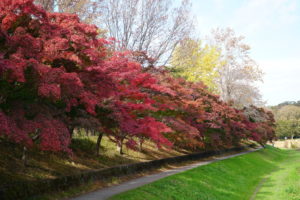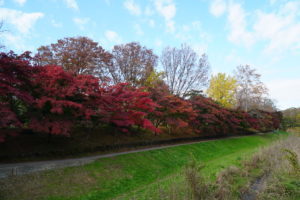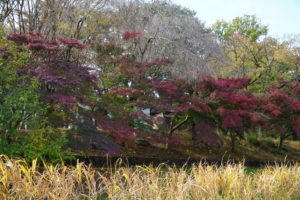Autumn Hanami
Cherry blossoms must be the most commonly painted, printed and loved image in all of Japanese aesthetics. Cherry blossoms pop up all year round on everything from T-shirts to chopstick wrappers to wallpaper. Universally and deeply loved, hanami flower viewing parties under the cherry blossoms seems to energize Tokyo like nothing else. However, there is another spectacular explosion of color in Tokyo that is often overlooked. Every fall for a couple of weeks, Tokyo’s maple trees burst out in red. This maple-viewing is a very different experience from the spring hanami, but one that transforms Tokyo in just as powerful of ways.
This fiery autumnal answer to the spring’s cherry blossoms is less bold, joyous and friendly than the cherries, but they are just as impressive in their own way, even if they are less noticed. Once autumn arrives, Tokyoites hurry along in heavier coats instead of stripping off their neckties and heavy blouses to loll around in April’s fresh splendor. The maple leaves will probably never be as openly loved as cherry blossoms because they are easier to miss. When the daylight is abbreviated and darkness falls early, Tokyoites start to hunker down, pull up their collars and look around less, facing inwards, compared to the extroverted pleasures of the spring.
The autumn’s maple trees are just as common and colorful, though. Like cherry trees, they are often planted together, but they never seem to conform to a total group effect, but stand individually. They are often hidden behind other plants, leaning over bushes and spurting up behind other trees. Scarcely distinguishable the rest of the year, the maples take over after waiting patiently for the locust and gingko to drop their yellow. Then, as if to prove patience and stamina, and a keen sense of timing, the maples erupt everywhere.
Once they are out, maples have a rough kind of beauty. The branches fall into unique cut-out shapes that fall into parallel layers of irregular branches. The maples not really very elegant, curved or smooth; they are more of a jerky folk dance than the fluid ballet of cherry trees. The cherry trees seem perfectly adapted to their Tokyo homes along canals, wide sidewalks, and throughout parks. Maples, though, seem a little awkward, not quite fitting in. When their leaves fall, it feels final and decisive, not like the next stage of fun when cherry blossoms whiten the ground or blanket a green canal in pink.
 The maple red feels more adult, pensive and serious than the cuter, younger pink and white of cherries. Never just a pure red, though, each maple tree has its own individual, description-defying color. The base red is always mixed with a little green at the edges, a layer of purple, a stroke of orange in the middle that makes the hue sharper, almost electric. Maple leaf red has a powerful, natural glow that comes from the eye moving between the green-orange-purple-red and finally a little gray on the back side, to pull in a shimmering constellation, a full spectrum, of redness.
The maple red feels more adult, pensive and serious than the cuter, younger pink and white of cherries. Never just a pure red, though, each maple tree has its own individual, description-defying color. The base red is always mixed with a little green at the edges, a layer of purple, a stroke of orange in the middle that makes the hue sharper, almost electric. Maple leaf red has a powerful, natural glow that comes from the eye moving between the green-orange-purple-red and finally a little gray on the back side, to pull in a shimmering constellation, a full spectrum, of redness.
Tokyo is usually so colorless. Few Tokyoites would buy a coat, a car, or a sofa with the intensity of maple red. Pink and white is reproduced all year round, but the complex maple colors you see only on the trees. Yet, it is this complicated, variegated aspect of maple red that creates their appeal. They have dignity, and a hint of melancholy, compared to the splashy, crowded throb of cherry blossoms. Maple leaves fit small, isolated temples, where the only sound is the faint crinkling of leaves; cherry trees fit big parks of rollicking, noisy party sounds. Tokyo’s character encompasses both moods, though it is easier remember the parties.
But, to stop and gaze up at the vibrant potency of the maple leaves’ color before catching the train home to a haphazardly heated apartment is to enter a moment of surreal beauty. We linger over the cherry blossoms, sitting for hours or walking until our feet hurt, but maple leaves we look at more quickly, with more immediate and penetrating effects. The dark reds and deep purples glow so strongly it is hard to look at them for long. They are dazzling. A quick glance is all that is needed before hurrying on.
We look at cherry trees in groups, but maples alone. Perhaps it is that experience of seeing them alone that frightens most Tokyoites off from looking more. Tokyo is lonely city in so many ways. That’s the pleasure of spring hanami: to see so many other people, all out of winter hibernation, all together, all in a good mood. You feel part of something bigger. But the maple leaves remind us of our singular existence, a reminder that most Tokyoites hardly need.
Cherry trees reaffirm one side of life in a big city–the noise, the people, the openness, the belonging, and the fun. Maple trees, though, remind us of more complex, enigmatic meanings and deeper, moody reflections. They remind us that Tokyo life has many aspects, but that one of our deepest, if most often ignored intuitions is that our place in the city is always also, in part, alone, or at least alone with a maple tree’s dignified beauty for solitary comfort.
(This was one of the very first pieces I wrote about Tokyo, over a dozen years ago. It appears in the second collection, Tokyo’s Mystery Deepens. It’s available from my website here and from online bookstores, too. It’s always been one of my favorites.)




